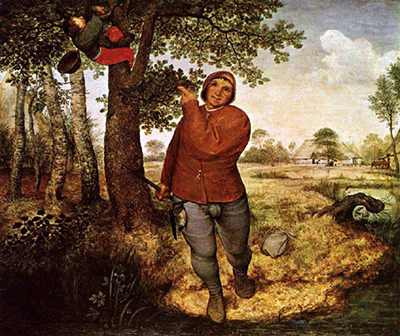The Peasant and the Nest Robber was painted in 1569, only a few months before Bruegel died.
The painting shows a peasant in the centre, dressed in the normal peasant clothing of his time. He is carrying a large stick and a knife case and horn is hanging from his belt. He is pointing towards the other man, the nest robber. As such, the peasant dominates the scene.
To one side, slightly behind him, we see a man hanging from a tree, obviously trying to steal eggs from a bird's nest. The splash of red that are his trousers bring our attention to him quickly.
While this painting does not seem to have any noticeable theme, on deeper digging, it appears to be a depiction of an old Dutch proverb: He who knows where the nest is, has the knowledge, he who robs, has the nest.
There could be many other interpretations in the other aspects of the painting as well. However, art connoisseurs have found The Peasant and the Nest Robber one of the most difficult of Bruegel's work to interpret in depth.
However, it has been suggested that this is a depiction of the Reformation with the nest robber representing the Reformers in the way they raided the churches.
Because of the varying interpretations of the painting, it is not sure whether it belongs in the peasant, religious, or proverbs genres, each of which Bruegel was adept at painting.
Pieter Bruegel was a Dutch Renaissance painter. His paintings were centred around the themes of proverbs, peasants and their daily lives, landscapes and Christianity. He was influenced by the works of Pieter Coecke van Aels, who was also his mentor. Based in Antwerp, Bruegel became an important voice during the Renaissance.




